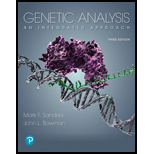
Concept explainers
What results from the experiments of Frederick Griffith provided the strongest support for his conclusion that a transformation factor is responsible for heredity?
To analyze:
Study the results of the Frederick Griffith experiment to analyze the conclusion that the transformation factor is responsible for heredity.
Introduction:
In
Explanation of Solution
In
In the first experiment, Griffith tried injecting mice with s strain and the mice died. Secondly, the mice were injected with heat-killed S strain of streptococcus, but surprisingly no death of mice was found. In the third experiment, the mice were injected with R strain, but no death occurred. Finally, when the heat-killed R strain of streptococcus was combined with harmless heat-killed S strain of streptococcus, he found that the mice are dead and the blood samples of the mice contain living S bacteria.

The transformation of R strain to s strain in mice supports the conclusion that Frederick, the transformation factor, causes the heredity.
From Frederick Griffith’s experiment, it is concluded that the transformation factor is responsible for heredity.
Want to see more full solutions like this?
Chapter 7 Solutions
Genetic Analysis: An Integrated Approach (3rd Edition)
- What are intrinsically disordered proteins, and how might they be useful for a living system?arrow_forwardWhat are Amyloid Fibrils? What biological functions are these known to perform?arrow_forwardHow do histamine and prostaglandins help in the mobilization of leukocytes to an injury site? What are chemotactic factors? How do they affect inflammation process?arrow_forward
- Compare and contrast neutrophils and macrophages. Describe two ways they are different and two ways they are similar.arrow_forwardDescribe the effects of three cytokines (not involved in the initial inflammation response). What cells release them?arrow_forwardDescribe activation of helper T cells or cytotoxic T cellsarrow_forward
- Compare and contrast MHC 1 and MHC 2. Describe two way they are different and two ways they similar including how they are used in antigen presentation.arrow_forwardDescribe two antimicrobial properties of the skin.arrow_forwardDescribe how the inflammation response starts including the sentinel cells and the chemicals involved. How do pathogens trigger the response particularly in the skin?arrow_forward
- How does complement promote the immune response? Describe three waysarrow_forwardWhich of the following is not a possible mechanism for autoimmunity? Select one: A. Abnormal expression of MHC II molecules in non-antigen-presenting cells B. Activation of polyclonal B cells C. Polymorphism of HLA alleles D. Molecular mimicry E. Release of sequestered antigensarrow_forwardWRITTEN WORK 3: NON-MENDELIAN GENETICS Part A: Complete the Punnett square and calculate for the probability of genotype and phenotype. i i Genotype: Phenotype: 08:55arrow_forward
 Human Biology (MindTap Course List)BiologyISBN:9781305112100Author:Cecie Starr, Beverly McMillanPublisher:Cengage Learning
Human Biology (MindTap Course List)BiologyISBN:9781305112100Author:Cecie Starr, Beverly McMillanPublisher:Cengage Learning
